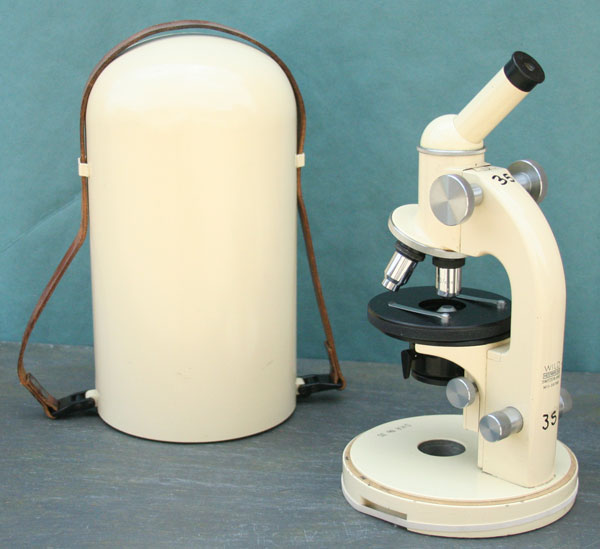
The Wild M11 Compound Microscope
by John Garrett, UK
Wild is a Swiss company, makers of optical instruments since 1921. They have made a wide range of microscopes, compound and stereo since then. Perhaps the most famous are the M20 compound and the M5 stereo, both highly sought-after and commanding high, some might say silly, prices. Quality doesn’t come cheap but the M11 has not yet achieved “collectable” status and can be obtained for a price that makes it a good choice where a small instrument that uses standard size eye-pieces and objectives is required.
The M11 was first produced in about 1954 and was shown in the brochure as being an “Expansible microscope, ideal for field-work, courses and laboratory”. Leaving aside the sheer weight of brass in such a solidly made instrument, which would have made it less than handy for field work, it was indeed a very adaptable microscope. It was compact rather than light-weight and Wild made a huge range of accessories for it, covering bright field and dark field, phase contrast and fluorescence for visual, photographic and ciné work. Polarising accessories were not listed in the catalogue that I have. This shows several photos of the M11 in use in the field with battery-powered illumination, tents in the background and an air of exploration.
Probably, its main application was in teaching, where laboratories in colleges and universities were equipped with as many as 80 in one class-room. Times were different then! Discussion tubes, drawing tubes and projection heads were available.
The most commonly found instrument has a monocular head with inclined eye-tube for a standard 23.2 mm eyepiece. (Fig. 1) Wild provided eyepieces with magnifications from 5x to 25x. Some were available as wide field, with a field number of 18.

Fig. 1
In addition to the 45° monocular head there is a straight (vertical) monocular head, suited to some photography, and a binocular head. (Fig. 2) This uses an adapter to fit to the tube. Two kinds of adapter were produced, one with an internal tube lens (Fig.3) and a shorter version that produced 1.5x magnification. Either kind may be used with the photo-tubes, which are the same as used for the M20, for example.
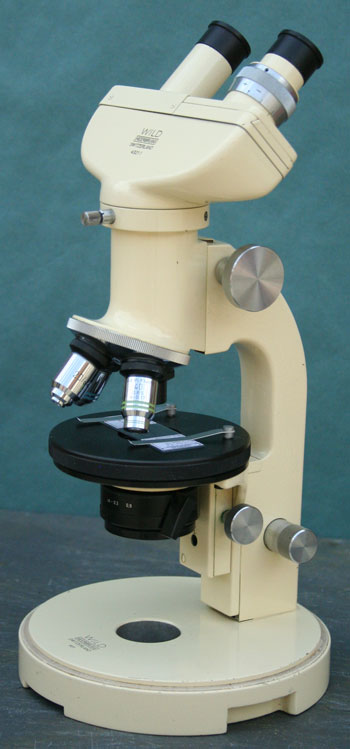
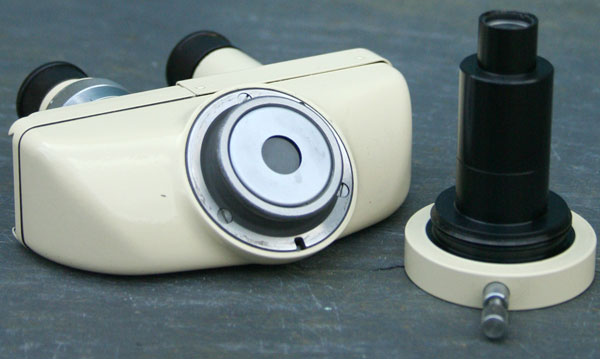
Figs. 2 and 3
The optical tube length is 160 mm and carries a 4-position nose-piece. Coarse focus moves the tube whilst the fine focus operates on the stage. Objectives are available from a range of achromatic, fluotar, plan-fluotar and epi-achromatic or epi-plan-fluotars, with magnifications from 2x to 100x. Phase contrast objectives are included in the range.
Four varieties of stage were produced. The simplest is the fixed circular stage. There is also a rotating, centring circular stage and a gliding, rotating stage, which is possibly the most common one to find now (Figs. 1 & 2). It is a delight to use, especially suited to easy tracking of moving specimens, for which a conventional X-Y mechanical stage can be difficult. However, the X-Y stage is also available (Fig. 4) as is a mechanical stage add-on for a standard stage.
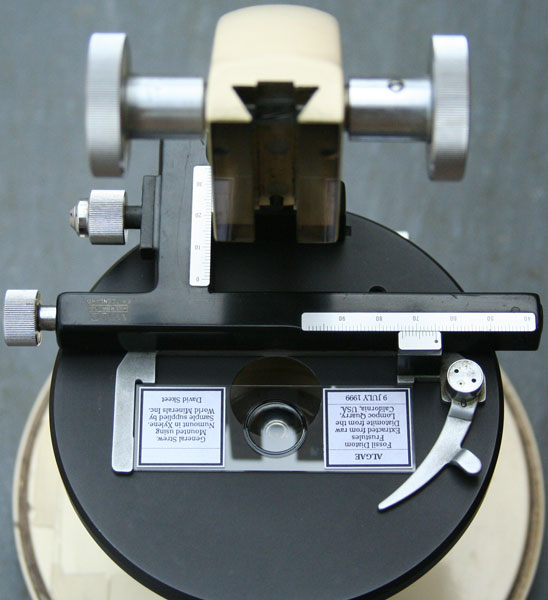
Fig. 4
Many different condenser configurations are available, ranging from a single lens with NA of 0.2 with add-on lens for NA 1.3 to achromatic-aplanatic with NA of 0.65 to 1.3. (Fig. 5) A commonly found condenser on ex-university microscopes is the NA 0.3/0.9 with swing-out top lens and iris diaphragm. (Fig. 6) Phase condensers with NA 0.9 to 1.45 and a long-working distance phase model with NA 0.52 were made.
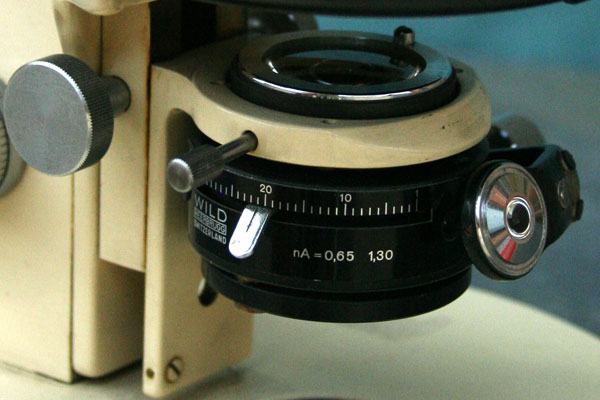
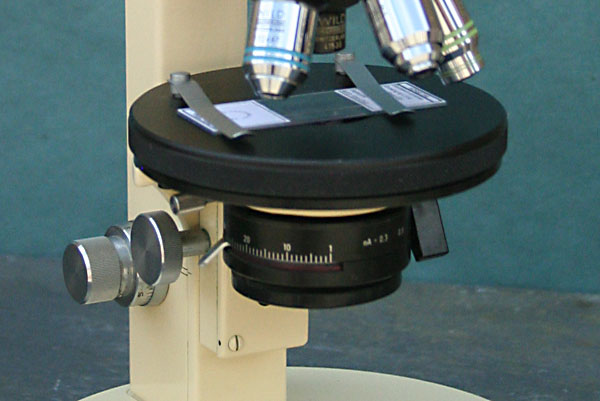
Figs. 5 and 6
The range of illumination options is also extensive. At simplest is the plano-concave mirror. There is also a simple lamp that attached to the condenser and one that would fit on the base (Fig. 7). The most complex is the Köhler illuminator (Fig. 8), which included an iris and a simple but very effective method for centring the lamp. The bulbs used are 6 V 20 W. A home-made LED replacement, with dimmer in the end, is shown in Fig .9 and a small, battery-operated LED lamp that fits within the hood is shown in Fig. 10.
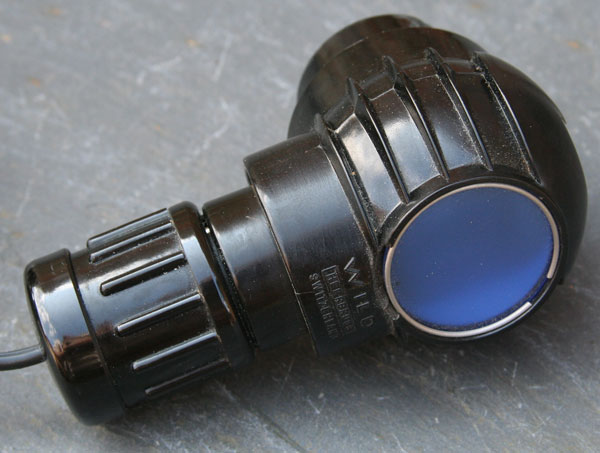
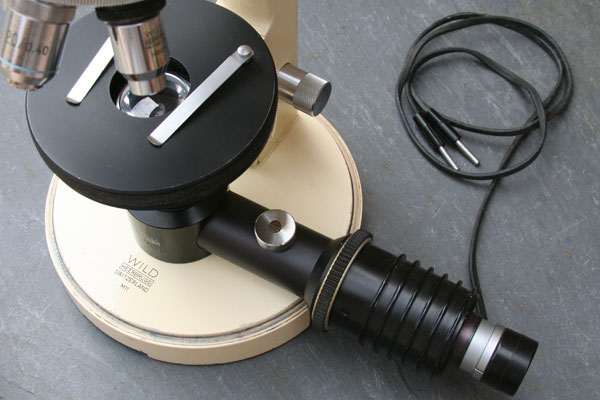
Figs. 7 and 8
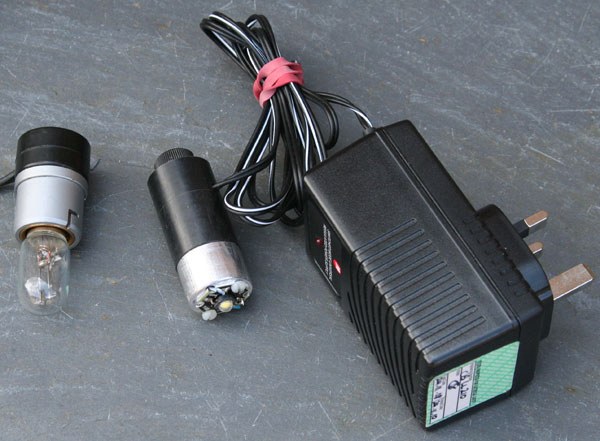
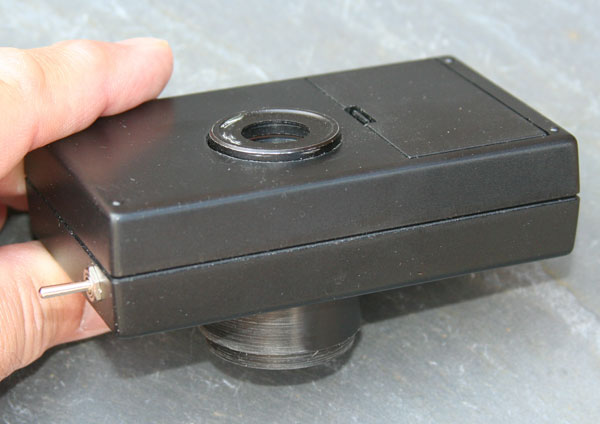
Figs. 9 and 10
Like the M9 before it, the M11 has a circular base 175 mm diameter. To this can fit a domed metal hood (Fig. 1) with leather carrying strap. Sadly, these are not often found with the M11s on the second-hand market and, when they are for sale, it is often as a price that is comparable with that of the basic instrument. Note that there are different heights of hood and that one to fit the M11 with binocular head is 370 mm tall, 50 mm taller than the version to fit the monocular instrument.
M11s, many in good condition, are available on the second-hand market. Though instruments with binocular heads and the adapters that are needed to attach them are not common, they sometimes appear on eBay for about £160 and I bought mine from LightScope Services. Mono instruments fetch less, perhaps £85 to £120, depending on the condition and optics provided. Most are sold without a power unit for the lamp so that should be allowed for in the overall cost. Even so, a very good quality instrument, likely to last many years, is obtainable for less than £200.
Comments to the author are welcomed.
Published in the July 2009 edition of Micscape.
Please report any Web problems or offer general comments to the Micscape Editor .
Micscape is the on-line monthly magazine of the Microscopy UK web site at Microscopy-UK
©
Onview.net Ltd, Microscopy-UK, and all contributors 1995
onwards. All rights reserved.
Main site is at
www.microscopy-uk.org.uk
with full mirror
at
www.microscopy-uk.net
.